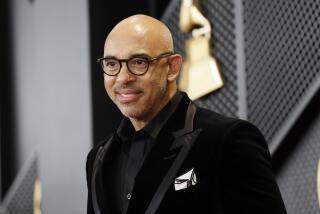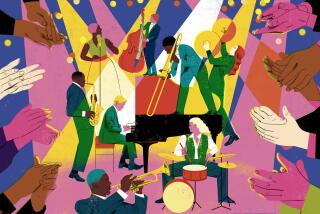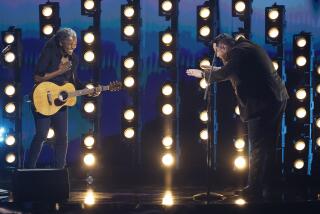Pierre Cossette dies at 85; ‘father’ of the Grammy Awards telecast
- Share via
Pierre Cossette, the avuncular old-school talent agent, manager, music mogul and Broadway producer often called the father of the Grammy Awards telecast for persuading nervous TV executives to put “longhairs with high heels and makeup” on a live national broadcast in 1971, died Friday. He was 85.
Cossette, who had suffered in recent years with congestive heart failure, died at Barrie Memorial Hospital in Montreal, not far from his family’s summer home in St. Anicet.
“He had a rough few years medically, but his spirit and sense of humor never left him,” Ken Ehrlich, the longtime Grammy Awards producer, said Friday shortly after learning of Cossette’s death. They continued to work together after Cossette formally retired in 2005 as the show’s executive producer. [Note: An earlier version of this article contained only the first part of Ehrlich’s quote.]
“Pierre was a creative visionary and one of the most accomplished, versatile and respected producers,” Recording Academy President Neil Portnow said in a statement. “It was because of his passion and dedication that the Grammy Awards came to network television close to 40 years ago.”
When Cossette approached officials at the National Academy of Recording Arts and Sciences in 1970 about making a live broadcast out of what until then had been a private ceremony mostly for record executives held in local hotel banquet rooms, they were skeptical. They had packaged their own Grammy highlights shows in the ‘60s, “Best on Record,” but they were low-rated affairs that ran months after awards had been handed out and all suspense was lost.
Cossette figured he could do with music what the film and TV academies had done since the ‘50s with the Oscar and Emmy telecasts, and paid $150,000 for the right to broadcast the award ceremony. He used money he had received from selling his interest in Dunhill Records, the label that he and Lou Adler formed in the early ‘60s that signed the Mamas & the Papas, Barry McGuire, Steppenwolf and Three Dog Night.
Still, it took considerable prodding before ABC bit. (After two years, the show moved to CBS, where it has remained.)
“Rock ‘n’ roll was not really an acceptable format in the television business in those days,” Cossette recalled in a 1985 interview. “The response was, ‘We don’t want those longhairs with their earrings and spike heels and makeup . . . on our network.’ ”
Landing Andy Williams as host wasn’t difficult because Cossette had worked as his manager during his years as an agent and manager for MCA representing clients who performed in Las Vegas, Reno and Lake Tahoe.
But it was a challenge at first to lure a live audience. Cossette himself stood outside the Hollywood Palladium inviting passersby inside for that first show in 1971, where Simon and Garfunkel swept the top categories with their “Bridge Over Troubled Water” song and album.
Pierre Maurice Joseph Cossette was born Dec. 15, 1923, in Valleyfield, Quebec, to Oswald and Annette Gendron Cossette, but he lived most of his life in Southern California after his family, including his older sister, Lise, moved to Altadena when he was 5. His father had hoped to find fame and fortune in the shade of Hollywood, but instead could only find work as a gas station attendant.
Pierre, however, showed a knack for procuring talent, securing comedian Red Skelton to perform at his high school.
During World War II, he joined the Army and served with an engineering battalion that built prisoner-of-war camps, often preceding Allied troops as they moved through Germany. His unit was charged with removing the bodies of German soldiers who had been killed.
“All of them were about our age,” he told The Times in 2005. “We would have to pick the bodies up by the heels and throw them on the truck.” That led to a phrase he used throughout his life to remind himself that no matter what setback he might be experiencing, “At least I’m not on the truck.”
Upon his discharge, he enrolled at USC as a journalism major -- he belatedly took great satisfaction in writing his 2003 memoir, “Another Day in Showbiz: One Producer’s Journey,” unaided -- and continued booking entertainment for campus events.
That led to MCA chief Lew Wasserman hiring him after Cossette graduated in 1949 to oversee the company’s casino bookings. His experience placating casino bosses of the era, coupled with his Army duties, laid the foundation for the air of unflappability for which he was famous.
“For a long time, I heard things like, ‘This act better be good, or I’ll break your . . . legs,’ ” he said in 2005. “I sweated my way through a lot of lounge acts, wondering if I’d be going home on crutches; by the time I’ve made it to [putting on the Grammy show at] Staples Center, what’s the worst thing that can happen?”
During those years, he discovered Ann-Margret and secured her first nightclub bookings.
Cossette reveled in creating unique performances on the Grammy show, such as in 1980 when he paired Barbra Streisand and Neil Diamond to sing their hit “You Don’t Bring Me Flowers,” and in 2001 when Elton John teamed up with Eminem on the controversial rapper’s hit “Stan.”
Cossette also continually tried to expand the Grammy show audience, shifting from the Palladium (then 600 seats) to the 5,000-seat Shrine Auditorium to the 19,000-seat capacity Staples Center in 2000. He often spoke of wanting to see it staged one day in a domed stadium before a crowd of 80,000.
Cossette’s son, John, joined his production company and has shared the title of executive producer of the Grammy telecast with Ehrlich in recent years.
Outside of the Grammy Awards show -- which yielded Cossette a trustees award in 1995 for contributions by a non-musician -- and the Latin Grammy telecast that he also oversaw, he produced syndicated series for Williams, Sammy Davis Jr., Glen Campbell and rock oldies group Sha Na Na, among more than 100 TV specials, awards shows, movies of the week and miniseries.
Cossette also produced several Broadway shows, including the six-time Tony Award-winning “The Will Rogers Follies.” He had recently been developing a new musical based on the life of Woody Guthrie.
He had long lobbied for a museum that celebrated the Grammys and popular music, and after unsuccessful bids to open one in New York and Memphis, Cossette finally got his wish when the developers of the sports and entertainment complex around Staples Center agreed to put one in.
The Grammy Museum at the Pierre Cossette Center at LA Live -- as the full name appears on the building -- opened in December.
“That was a very big thing for him,” said longtime Grammy show director Walter C. Miller. “I was there when they paid tribute to him when it opened. I think it was the capper for him.”
Grammy Museum Executive Director Robert Santelli said in a statement, “We’re especially pleased that he was able to see his hard and wonderful work throughout so many of our exhibits, where thousands of people will now have the opportunity to celebrate his legacy.”
In addition to his son John, Cossette is survived by another son, Andrew, from his marriage to Dorothy Foy, who died in 1982; as well as his second wife, Mary; five stepchildren, Jennifer Bontempo, Anne Casey, Christopher Ufland, John Ufland and Joslin Weiner; and eight grandchildren.
Services are pending. His family has requested than instead of flowers, donations be made to the Recording Academy’s MusiCares charitable foundation, 3030 Olympic Blvd., Santa Monica, CA 90404 Attn: Dana Tomarken.
More to Read
Start your day right
Sign up for Essential California for the L.A. Times biggest news, features and recommendations in your inbox six days a week.
You may occasionally receive promotional content from the Los Angeles Times.






